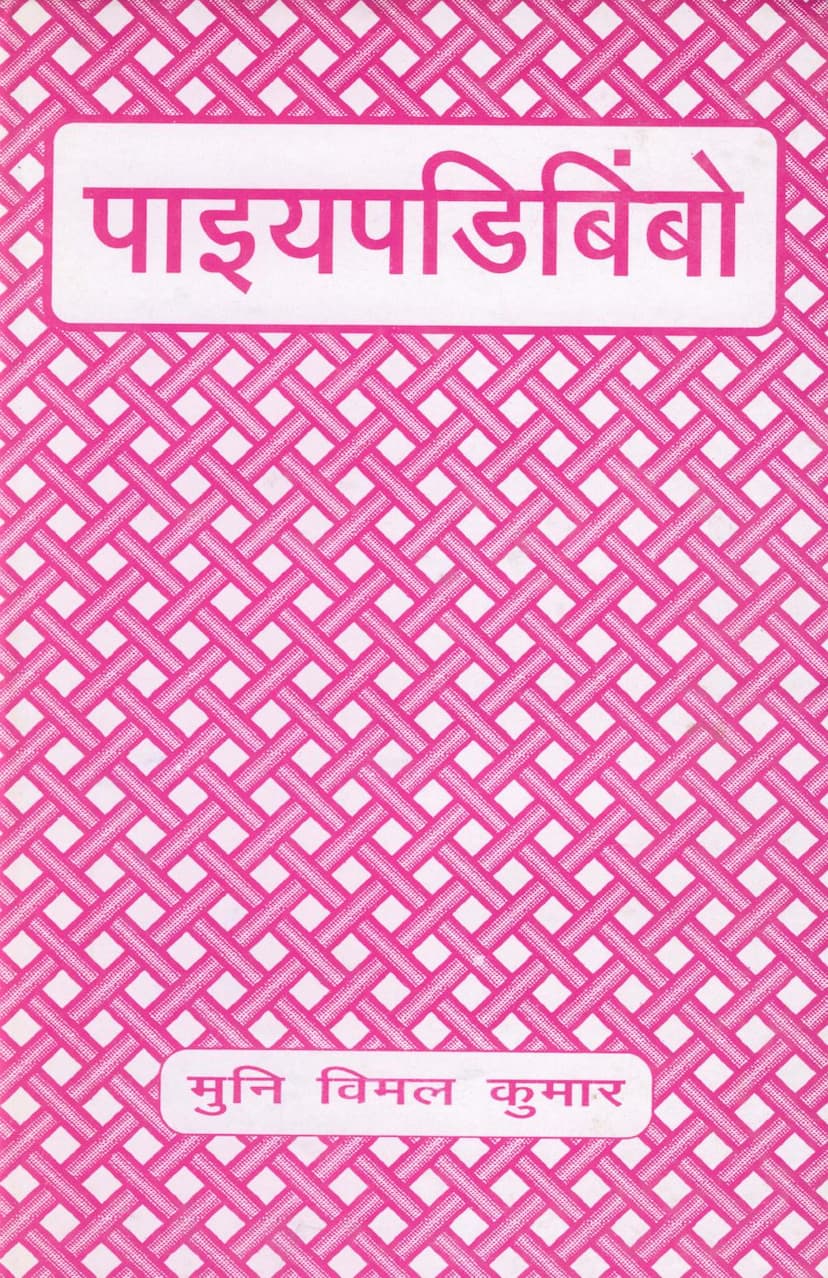Paia Padibimbo
Added to library: September 2, 2025

Summary
This document contains a Jain text titled "Paia Padibimbo" (पाइयपडिबिंबो), authored by Vimalmuni (मुनि विमल कुमार). Published by Jain Vishva Bharati, Ladnun (Raj.), it is a collection of three poetic works in the Prakrit language.
Here's a comprehensive summary based on the provided pages:
Overall Theme and Purpose:
"Paia Padibimbo" translates to "Reflection in Prakrit." The book aims to revive and promote the study and creation of literature in the Prakrit language, which is considered sacred and important within Jainism. The author, Muni Vimalkumar, demonstrates his proficiency in Prakrit by composing these poetic works, which are intended to be useful for students of Prakrit and readers who appreciate the language.
Key Works within "Paia Padibimbo":
The book contains three distinct poetic narratives (kavyas), each based on Jain traditions and stories:
-
Laliyangachariyam (ललियंगचरियं): This is a narrative poem based on an ancient historical tale. It is divided into four cantos (sargas), each written in different meters. The story revolves around Prince Lalitang, known for his generosity. When his father, King Naravahan, restricts his charitable donations, Lalitang is forced to leave the kingdom. His journey involves encountering deceitful friends and tests of faith, ultimately leading him to discover a remedy for a princess's blindness, which results in his marriage and the establishment of a just kingdom.
-
Devadatta (देवदत्ता): This work is based on the ninth chapter of the first section of the Jain Agam scripture 'Viyagasuyam' (विवागसुयं). It tells the story of Devadatta, a virtuous and beautiful maiden from Rohitak city, who marries Prince Pushyanandi. Due to her ambition and influence of negative associations, Devadatta tragically kills her mother-in-law, leading to her own brutal punishment and a cycle of karmic consequences across multiple lifetimes, ultimately leading her towards spiritual liberation.
-
Subahucharim (सुबाहुचरियं): This narrative is based on the first chapter of the second section of the 'Viyagasuyam' Agam. It tells the story of Prince Subahu, who is known for his virtue and generosity. After receiving spiritual guidance from Lord Mahavir, he embraces the layperson's path (agar-dharma) and later renounces the world to become a monk. His life story illustrates the principles of Jain conduct and leads to his eventual liberation.
Author's Intent and Approach:
- Revival of Prakrit: Muni Vimalkumar's primary motivation is to contribute to the living tradition of Prakrit literature. He acknowledges the difficulty of writing in Prakrit, especially poetry, but perseveres due to his deep study and passion.
- Educational Value: The author has provided Hindi translations for each poem. Additionally, he includes explanations of difficult words and references to Hemachandracharya's Prakrit grammar in the footnotes, making the text accessible and educational for learners. The use of the 'Payalacchinamala' (पाइयलच्छी नाममाला) for word proofs further enhances its academic value.
- Dedication: The book is dedicated to his spiritual guides, Ganaadhipati Tulsi and Acharya Mahapragya, who inspired and guided his literary endeavors.
- Personal Journey: Muni Vimalkumar shares his personal journey of learning Prakrit, starting with an initial interest and developing into a serious study, which was encouraged by his gurus. He credits his teachers for their inspiration and guidance.
Endorsements and Forewords:
The book features forewords and blessings from prominent Jain scholars and leaders:
- Ganaadhipati Tulsi: Highlights the rich literary tradition of the Terapanth sect and the importance of Prakrit. He praises Muni Vimalkumar's dedication and the book's utility for Prakrit learners.
- Acharya Mahapragya: Emphasizes Prakrit as a "language of the people" and its significance for Jain monks. He commends Muni Vimalkumar's studiousness and skill in composing poetry in Prakrit, calling it a valuable addition to Jain literature.
- Mahashraman Muni Muditkumar: Appreciates Muni Vimalkumar's expertise in Sanskrit and Prakrit and expresses hope that the book will be beneficial for students and readers.
- Dr. Satyarajan Banerjee (Professor, Calcutta University): Provides a detailed introduction, appreciating the author's courage in writing Prakrit poetry in the modern era. He highlights the poetic beauty, clarity of language, and the scholarly references within the book, emphasizing its value for learning Prakrit and understanding Jain narrative traditions.
Structure and Content:
- The book begins with Mangalacharan (mangalacharan), invoking blessings.
- Each of the three kavyas is divided into Sargas (सर्ग) or cantos, detailing the narrative.
- Katha-vastu (कथावस्तु) provides a summary of each story.
- Parishishta (परिशिष्ट) includes:
- Kavyagat Suktiyon (कव्वागयसुत्तीओ): A collection of wise sayings and aphorisms from the poems.
- Shabda Suchi (सद्दसूई): A glossary of important or difficult words used in the text.
In essence, "Paia Padibimbo" is a scholarly and devotional work that seeks to preserve and propagate the literary heritage of Jainism through the medium of Prakrit poetry. It reflects the author's deep commitment to his faith and to the revival of ancient languages.